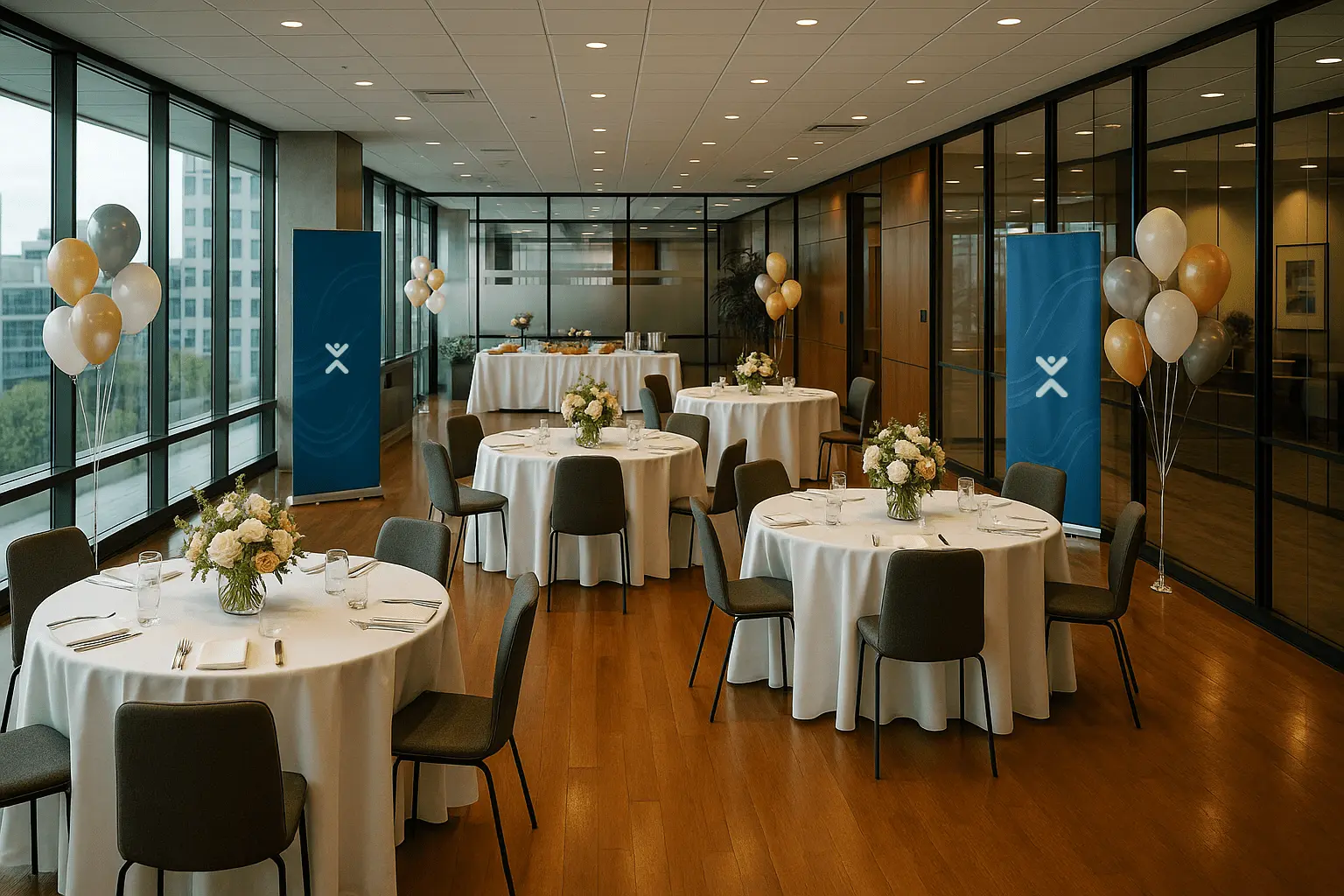Planning an offsite should not require heroics or a spare lifetime. With clear goals, the right venue and a realistic timeline, you can plan corporate offsite days that deliver outcomes, not just invoices. If you need space options fast, our team can help you compare office space across the UK and shortlist locations with great meeting facilities.
Offsites are most effective when they are simple, purposeful and built around your people. That means picking a date that works, setting a few measurable outcomes and choosing a venue that supports the work you want to do. If your team is London based, it is easy to browse office space in London breakout areas that suit different formats.
Key takeaways
- To plan a corporate offsite well, set 2–3 outcomes first
- Plan corporate offsite budgets early to lock rates and transport
- Plan corporate offsite venues around format, not postcode
- Plan corporate offsite agendas with short sessions and breaks
- Plan corporate offsite safety with risk checks and contacts
- Plan corporate offsite follow-ups within 48 hours
Set clear objectives and success measures
Start by writing one sentence that explains why you are taking people away from their normal week. If you cannot explain it in one sentence, the plan needs focus. Typical aims include strategy alignment, cross-team collaboration or kicking off a project.
Translate the aim into two or three outcomes you can measure within 30 days. Examples include a ranked strategy backlog, a one-page roadmap or three documented decisions. Decide how you will track those outcomes and who owns each one.
Who is the offsite for?
Design the day for the actual people attending, not a hypothetical ideal team. Consider energy levels, accessibility needs and whether you will have a mix of senior leaders and early career attendees. If you need advice on space types, compare options on the Types of office space guide.
What outcomes matter?
List the decisions or artefacts you want by the end of the day. Keep it tight and focus on the few items that make a difference. If you need a deeper primer on workspace trade-offs, this walkthrough on flexible office space benefits and costs can help you match room setups to your agenda.
Budget, approvals and tax basics
Create a line item budget with a 10% contingency. Include venue, AV, facilitator, travel, accommodation, catering, printing and incidentals. If your event has a social element, check whether it falls within HMRC’s annual function rules, as set out in tax rules for staff social functions.
Approve the budget before you contact suppliers, then lock provisional holds with clear release dates. Track approvals in your project board so finance and HR do not become blockers later on. For reference pricing in major cities, use this overview of office space costs in UK cities to sense-check your estimates.
Avoid month-end, school holidays and industry conference weeks. Hybrid teams benefit from off-sites that complement their working pattern rather than challenge it. Rigorous trial evidence indicates hybrid working reduces attrition by about one third without hurting performance, as summarised in a Nature research highlight.
Choose a format that fits your goals, for example, a strategy sprint, cross-functional lab, leadership forum or team reset. Pick short sessions, regular breaks and generous buffer time so people can process and contribute.
Choose a venue that fits your goals
The venue should make the work easier. Look for natural light, phone booths for private calls, small rooms for breakouts and a main room with flexible seating. If you need privacy or bespoke branding, a managed or serviced space can be smarter than a hotel.
You can compare serviced office options for plug-and-play setups, or review managed office space if you want more control.
Travel time matters, so keep the total door-to-door journey under 90 minutes for most attendees if possible. For London teams hosting clients, browse the City of London workspace to stay central without sacrificing quiet rooms for breakouts.
Ask every venue about Wi-Fi capacity, hard-line internet, AV kit, desk mics for larger rooms and on-site support. Confirm load-in times and any fees for extended hours, then put every promise into the contract.
Build an agenda people actually want
Aim for 45–60 minute blocks with 15-minute breaks. Alternate between divergent and convergent activities, such as idea generation followed by prioritisation. Use clear facilitation rules so discussions do not drift.
Limit slide decks and prefer short briefs with live collaboration. Mix plenary work with breakouts of 4–6 people, then build in a short reflection time so quieter voices can gather thoughts before group share-outs.
People, accessibility and duty of care
Start with a simple risk assessment that fits the scale of your event. The Health and Safety Executive provides practical event safety guidance that you can adapt to your context.
If attendees will travel, align your process with the ISO travel risk standard. ISO sets out a structured approach to policy, risk assessment and incident response in ISO 31030 travel risk management.
Be thoughtful with personal data and collect only what you need. Use consent for special category data such as dietary or access requirements, as set out in the ICO’s notice for attending an event, seminar or workshop.
Logistics and supplier checklist
You do not need a novel-length list, but you do need the moving parts that break plans. Focus on the essentials and keep them in one place for the team running the day.
- Venue contract, insurance and access instructions
- AV kit, spares and the direct number of the technician
- Catering timings, allergens sheet and dietary flags
- Signage and room plans, including a quiet space
- Transport info and late arrival guidance
- Registration list, name badges and privacy notice
- Emergency plan, contacts and first aid kit
Comms timeline and tooling
Announce the offsite with the purpose, the date and travel expectations. Three weeks out, share the high-level agenda and venue details. One week out, publish session owners and pre-reads, then send a practical reminder the day before with transport advice and support contacts.
Use lightweight tools on the day, for example, a single shared document for decisions and a Kanban board for actions. If your team might stay on after the event, consider hosting it near a space with handy breakout areas by exploring central London office space.
On the day run sheet
Create a one-page schedule with times, owners and locations. Include a tech check 45 minutes before start, a buffer after lunch and a 20-minute decisions review before you close.
Assign a roaming problem solver to handle facilities questions, room resets and late arrivals. If you split into breakouts, stagger their start times by a couple of minutes so people can move without bottlenecks.
Aftercare and measuring impact
Share notes within 24–48 hours and convert decisions into owner-dated actions. Book any follow-up workshops while energy is still high, then check in at two weeks with a short pulse survey on outcomes and usefulness.
If the offsite is part of your hybrid rhythm, track delivery against a normal week. The underlying trial shows no performance loss but a strong retention effect, which is detailed in the Nature paper on hybrid work and retention.
Templates and a 12-week timeline
You can adapt this skeleton to team size and scope. Start earlier for large or multi-day events and add time for international travel approvals and visas if required.
- Weeks 12–10: define objectives, budget, attendees, shortlist venues, hold dates
- Weeks 9–8: confirm venue and contracts, book travel holds, draft agenda, identify facilitators
- Weeks 7–6: risk assessment, accessibility plan, AV brief, catering brief, collect dietary needs
- Weeks 5–4: send save the date with purpose, confirm session owners, prepare pre-reads
- Weeks 3–2: final agenda, room plan, kit list, tech test with the venue, publish travel info
- Week 1: send joining instructions, pack spares, brief support team and execs
- Event day: run sheet in hand, start on time, capture decisions, protect breaks
- Week +1: circulate notes and actions, send survey, book follow-ups
- Week +4: review outcomes and impact, close actions, update playbook
If you expect to repeat the format across regions, create a simple playbook and store a copy with your facilities team. When ready to scale, ask our team for a shortlist of serviced offices with on-site meeting rooms near your main hubs.
Conclusion
The fastest way to plan corporate offsite days that work is to simplify. Set a purpose, pick a venue that supports the work, run a human agenda and close with decisions. When the space helps rather than hinders, everything is easier.
If you want flexible layouts with support on tap, explore managed office space options and build your offsite around rooms that fit the work.
FAQs
How far in advance should I plan a corporate offsite?
For a one-day event with local travel, 8–10 weeks is usually enough. For multi-day or cross-border events, start 12–16 weeks ahead to secure the right venue and rates.
What is the ideal group size?
Keep plenary sessions under 24 people where possible. Use breakouts of 4–6 to keep contributions flowing and ensure voices are heard.
How long should each session be?
Aim for 45–60 minutes with 15-minute breaks. People stay engaged when sessions are short and outcomes are clear.
Do I need a professional facilitator?
If your agenda includes complex decisions or sensitive topics, hire one. For routine planning, a competent internal chair with a clear script is usually fine.
What if my team is fully remote?
Choose a venue near strong rail links and keep the schedule tight. Provide quiet spaces for calls and stick to a single shared notes doc so remote habits carry over cleanly.
















